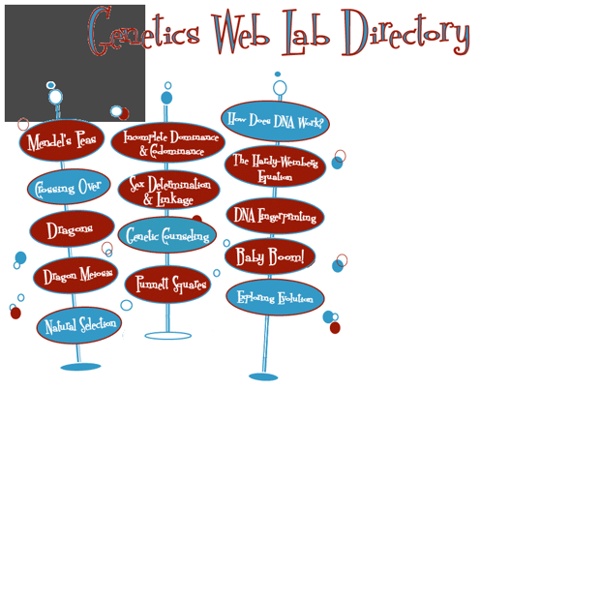



Cell, Socks, and Sex Cell, Socks, and Sex Description: This is a fun, easy way to teach the process of mitosis and meiosis. This will strengthen vocabulary concepts like homologus pairs, diploid, haploid, tetrad and many others. This lesson will also clear up concepts like sexual determination, trisomy and even twining. Materials: Four or five pairs of socks. Lesson Plan: I start with a long, striped piece of fabric that has been twisted hundreds of times to represent chromatin material. I use socks with colored stripes, so that I can easily make reference to the genes in them, but add the idea of homologous chromosomes and alleles. I use a similar approach to teach meiosis. Now, I add the sex chromosomes to the original autosomal chromosomes. While singing Sthe race is on and here comes Clyde in the back stretch,S the sperm swims a bit and meets the egg. Fellows Collection Index Activities Exchange Index
Free Knitting Patterns - Baby's First DNA Model - Kimberly Chapman's Knitting Copyright © 2005-2008, Kimberly Chapman. All knitting graphics/patterns/instructions on this page were created by Kimberly Chapman. You may link to this page, but please do not steal/hotlink the graphics or copy the patterns to other sites without my written permission. Yarn: Red Heart Super Saver acrylic in black, orange, green, yellow, and blue Needles: US 3 double-pointed (see my double-pointed needle tutorial to learn how they work) The DNA model was made with two equal black twisted tubes using the right-twist variation of self-twisting tubes. The base pairs were 9 stitches around, or 3 per needle. 6th row: 2 yellow, 3 blue, 2 yellow, 2 blue7th row: 3 yellow, 2 blue, 3 yellow, 1 blue8th row: 4 yellow, 1 blue, 4 yellow Then the 9th through 13th rows were all yellow, then a binding off row of yellow. The orange-green ones were one cast-on row of orange, then 5 rows of orange, then as follows: Then the 8th through 13th rows were all green, then a binding off row of green.
DNA from the Beginning - An animated primer of 75 experiments that made modern genetics. Biotechnology Science Fair Project Ideas Please ensure you have JavaScript enabled in your browser. If you leave JavaScript disabled, you will only access a portion of the content we are providing. <a href="/science-fair-projects/javascript_help.php">Here's how.</a> {*style:<b>Free Biotechnology Science Fair Project Ideas </b>*} All living things are made of cells and share the same basic cellular machinery. Information about an organism based on DNA analysis Chemical reactions and pathways that are important in living organisms Modern genetic engineering techniques (such as isolating and/or manipulating DNA) Learn about and employ several fascinating real-world tools and techniques with these biotechnology science fair project ideas. Please select from the following difficulty levels: You can find this page online at: You may print and distribute up to 200 copies of this document annually, at no charge, for personal and classroom educational use.
Dragon Delivery | Home | K20alt Lesson Snapshot 1. Engage: Students will watch a video or look at a picture and identify all of the similarities and differences of dragons. 2. 3. 4. 5. BioQUEST Curriculum Consortium | Biology Curriculum Development | Curriculum Resources Epigenetics II: DNA Methylation in Arabidopsis Jermel Watking, Bruce Nash, and David Micklos DNA Learning Center, Cold Spring Harbor Laboratory Although DNA is the blueprint of life, not all genes are actively expressed in every cell within a multicellular organism. As discussed in our Carolina Tips® article, "Epigenetics I: Using Carolina Corn Ears to Teach Genetic Imprinting," phenotypic differences between cells occur because genes are turned on or off in a cell-specific way. Arabidopsis, FWA, and DNA methylation One very important step in plant development is the switch from vegetative growth to flowering for sexual reproduction. FWA is normally expressed in endosperm, a tissue that feeds the seedling but does not contribute to the structure of the adult. Classroom application To study this homeotic mutation, you can grow Arabidopsis seed in your class. This relatively simple experiment offers a sophisticated test for specific chemical changes to DNA that act as an important developmental regulator in plants.
Partnership for Plant Genomics Education Double Blasted In early August of 1945, Tsutomu Yamaguchi had a run of the worst luck imaginable. A double blast of radiation left his future, and the future of his descendants, in doubt. In this short: an utterly amazing survival story that spans ... well, 4 billion years when you get down to it. On the morning of August 6th, 1945, Tsutomu Yamaguchi was in Hiroshima on a work trip.